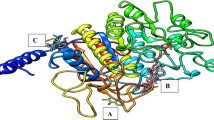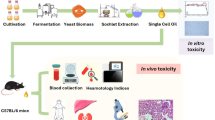Abstract
The use of bamboo as herbal remedy has long been mentioned in ancient pharmacopeias but its use in the medicinal world has not been in vogue. Various health-promoting activities of bamboo have been documented, but less emphasis has been placed on the in vivo studies of bamboo shoots. To assess the health-promoting activities of the shoots, the toxicity profile was evaluated. Three different doses of fresh shoot, viz, 200, 400, and 800 mg/kg body weight, were administered to LACA male mice and were compared to control mice for 60 days. Phytochemical estimations of fresh shoots of edible bamboo Bambusa nutans revealed the presence of several bioactive compounds such as phenols, flavonoids, coumarins, phytosterols, saponins, tannins, and triterpenes. No lethality and prominent physiological difference were observed throughout the treatment period. Blood glucose level increased slightly in 800 mg/kg body weight group but was in the normal range. Histology of liver, kidney, and pancreas revealed some alteration in liver of high dose administered group whereas no alteration was observed in other organs in all groups. Biochemical alteration of serum was observed in case of serum lactate dehydrogenase, and reduced glutathione levels and whole blood lipid peroxidase levels were observed in all plant extract–treated groups compared to control. Considering these results, all the considered doses of Bambusa nutans extract can be contemplated safe as no adverse toxicity and lethality were observed in the study.









Similar content being viewed by others
Data Availability
The datasets generated/analysed during the current study are available from the authors on reasonable request.
References
Adekomi DA, Ibiyeye RY, Popoola AN, Oyesomi OT (2011) Activities of G6PDH and LDH in the kidney, liver and pancreas of adult Wistar rats following the administration of ethanolic leaf extract of Madagascar periwinkle (Catharanthus roseus). Asian J Cell Biol 6(2):81–88. https://doi.org/10.3923/ajcb.2011.81.88
Al-Afifi NA, Alabsi AM, Bakri MM, Ramanathan A (2018) Acute and sub-acute oral toxicity of Dracaena cinnabari resin methanol extract in rats. BMC Complement Altern Med 18(1):1–14. https://doi.org/10.1186/s12906-018-2110-3
Bajwa HK, Santosh O, Koul A, Bisht MS, Nirmala C (2019) Sub-acute oral toxicity evaluation of aqueous extract of bamboo shoots (Dendrocalamus hamiltonii) in Balb/c mice. J Food Safety Hygine 5(3):137–145. https://doi.org/10.18502/jfsh.v5i3.5690
Bajwa HK, Santosh O, Koul A, Bisht MS, Nirmala C (2021) Phytomodulatory effects of Dendrocalamus hamiltonii (Nees & Arn Ex Munro) shoots on the hepatic status of healthy male Balb/c mice. J Pharmacogn Phytochem 10(1):1860–1865
Bala S, Chugh NA, Bansal SC, Garg ML, Koul A (2017) Safety evaluation of Aloe vera pulp aqueous extract based on histoarchitectural and biochemical alterations in mice. Indian J Exp Biol 55:568–575
Barham D, Trinder P (1972) An improved colour reagent for the determination of blood glucose by the oxidase system. Analyst 97(1151):142–145. https://doi.org/10.1039/an9729700142
Bergmeyer HU, Bernt E (1971) In methods of enzymatic analysis II. Academic Press, New York, pp 5574–55579
Bhosale VV, Banerjee D (2020) Scientific Validation of Herbal Medicine. In: Sen S, Chakraborty R (eds) Herbal Medicine in India. Springer, Singapore. https://doi.org/10.1007/978-981-13-7248-3_34
Chongtham N, Bisht MS (2020) Bamboo shoot: superfood for nutrition, health and medicine. CRC Press, New York
Chongtham N, Bisht MS, Haorongbam S (2011) Nutritional properties of bamboo shoots: potential and prospects for utilization as a health food. Compr Rev Food Sci Food Saf 10(3):153–168. https://doi.org/10.1111/j.1541-4337.2011.00147.x
Chongtham N, Bisht MS, Premlata T, Bajwa HK, Sharma V, Santosh O (2021) Quality improvement of bamboo shoots by removal of antinutrients using different processing techniques: a review. J Food Sci Technol 59(1):1–11. https://doi.org/10.1007/s13197-021-04987-9
El Omari N, Guaouguaou FE, Bouyahya A (2022) Natural bioactive compounds from medicinal plants as antibacterial drugs: mechanism insights and clinical perspectives. Curr Top Med Chem. https://doi.org/10.2174/1568026622666220330011255
El-Saadony MT, Zabermawi NM, Zabermawi NM, Burollus MA, Shafi ME, Alagawany M, Yehia N, Askar AM, Alsafy SA, Noreldin AE, Khafaga AF, Dhama K, Elnesr SS, Elwan HAM, Di Cerbo A, El-Tarabily KA, El-Hack MEA (2021) Nutritional aspects and health benefits of bioactive plant compounds against infectious diseases: a review. Food Rev Int 1–23. https://doi.org/10.1080/87559129.2021.1944183
Farhana A, Lappin SL (2020) Biochemistry, lactate dehydrogenase. StatPearls [Internet]. https://www.ncbi.nlm.nih.gov/books/NBK557536
Franklin DC (2005) Vegetative phenology and growth of a facultatively deciduous bamboo in a Monsoonal Climate 1. Biotropica: J Biol Conserv 37(3):343–350. https://doi.org/10.1111/j.1744-7429.2005.00045.x
Humanson LG (1961) Animal tissue technique II. W. H Freeman and Company, San Francisco
Indira A, Santosh O, Koul A, Nirmala C (2022) Comparative assessment of the antioxidant potential of bamboo leaves, along with some locally and commercially consumed beverages in India. Advances in Bamboo Science 1:100007. https://doi.org/10.1016/j.bamboo.2022.100007
Ju J, Song JL, Park KY (2015) Antiobesity effects of bamboo salt in C57BL/6 mice. J Med Food 18(6):706–710. https://doi.org/10.1089/jmf.2014.3271
Kato GJ, McGowan V, Machado RF, Little JA, Taylor J, Morris CR, Nichols JS, Wang X, Poljakovic M, Morris SM Jr, Gladwin MT (2006) Lactate dehydrogenase as a biomarker of hemolysis-associated nitric oxide resistance, priapism, leg ulceration, pulmonary hypertension, and death in patients with sickle cell disease. Blood 107(6):2279–2285. https://doi.org/10.1182/blood-2005-06-2373
Kaur H (2017) Phytomodulatory effects of fresh and processed shoots of Dendrocalamus hamiltonii on lipid profile and antioxidant defense system. A Ph.D. thesis submitted to Panjab University, Chandigarh, India
Kiruba S, Jeeva S, Das S, Kannan D (2007) Bamboo seeds as a means to sustenance of the indigenous community. Indian J Traditional Knowledge 6(1):199–203 (http://nopr.niscair.res.in/handle/123456789/907)
Koul A, Bala S, Arora N (2015) Aloe vera affects changes induced in pulmonary tissue of mice caused by cigarette smoke inhalation. Environ Toxicol 30(9):999–1013. https://doi.org/10.1002/tox.21973
Moron MS, Depierre JW, Mannervik B (1979) Levels of glutathione, glutathione reductase and glutathione S-transferase activities in rat lung and liver. Biochim Biophys Acta (BBA)-Gen Subjects 582(1):67–78
Nam JS, Chung HJ, Jang MK, Jung IA, Park SH, Cho SI, Jung MH (2013) Sasa borealis extract exerts an antidiabetic effect via activation of the AMP-activated protein kinase. Nutr Res Pract 7(1):15–21. https://doi.org/10.4162/nrp.2013.7.1.15
Nath P, Yadav AK (2015) Acute and sub-acute oral toxicity assessment of the methanolic extract from leaves of Hibiscus rosa-sinensis L. in mice. J Intercult Ethnopharmacol 4(1):70. https://doi.org/10.5455/jice.20141028021746
Nirmala C, Bisht MS, Bajwa HK, Santosh O (2018) Bamboo: a rich source of natural antioxidants and its applications in the food and pharmaceutical industry. Trends Food Sci Technol 77:91–99. https://doi.org/10.1016/j.tifs.2018.05.003
Panda T, Padhy RN (2007) Sustainable food habits of the hill-dwelling kandha tribe in kalahandi district of Orissa. Indian J Tradit Knowl 6(1):103–105
Patel M, Mehta P (2021) Bamboo a supplement to human health: a comprehensive review on its ethnopharmacology, phytochemistry, and pharmacological activity. Nat Prod J 11(2):140–168. https://doi.org/10.2174/2210315510666200101092551
Pérez-Rodríguez L, Romero-Haro AA, Sternalski A, Muriel J, Mougeot F, Gil D, Alonso-Alvarez C (2015) Measuring oxidative stress: the confounding effect of lipid concentration in measures of lipid peroxidation. Physiol Biochem Zool 88(3):345–351. https://doi.org/10.1086/680688
Rathour R, Kumar H, Prasad K, Anerao P, Kumar M, Kapley A, Pandey A, Kumar Awasthi M, Singh L (2022) Multifunctional applications of bamboo crop beyond environmental management: an Indian prospective. Bioengineered 13(4):8893–8914. https://doi.org/10.1080/21655979.2022.2056689
Rawat K, Sharma V, Saini N, Nirmala C, Bisht MS (2016) Impact of different boiling and soaking treatments on the release and retention of antinutrients and nutrients from the edible shoots of three bamboo species. Am J Food Sci Nutr Res 3(3):31–41
Roy A, Khan A, Ahmad I, Alghamdi S, Rajab BS, Babalghith AO, Alshahrani MY, Islam S, Islam MR (2022) Flavonoids a Bioactive Compound from Medicinal Plants and Its Therapeutic Applications. BioMed Res Int 2022. https://doi.org/10.1155/2022/5445291
Saini N (2019) Self life enhancement of juvenile shoots of edible bamboos through different processing and preservation techniques and evaluation of their phytochemicals. A Ph.D. thesis submitted to Panjab University, Chandigarh, India
Senthilkumar MK, Sivakumar P, Changanakkattil F, Rajesh V, Perumal P (2011) Evaluation of anti-diabetic activity of Bambusa vulgaris leaves in streptozotocin induced diabetic rats. Int J Pharm Sci Drug Res 3(3):208–210
Shahidi F, Zhong Y (2015) Measurement of antioxidant activity. J Funct Foods 18:757–781. https://doi.org/10.1016/j.jff.2015.01.047
Trush MA, Mimnaugh EG, Ginsburg E, Gram TE (1981) In vitro stimulation by paraquat of reactive oxygen-mediated lipid peroxidation in rat lung microsomes. Toxicol Appl Pharmacol 60(2):279–286
Vaou N, Stavropoulou E, Voidarou C, Tsakris Z, Rozos G, Tsigalou C, Bezirtzoglou E (2022) Interactions between medical plant-derived bioactive compounds: focus on antimicrobial combination effects. Antibiotics 11(8):1014. https://doi.org/10.3390/antibiotics11081014
Zhang Y, Wu X, Ren Y, Fu J, Zhang Y (2004) Safety evaluation of a triterpenoid-rich extract from bamboo shavings. Food and Chem Toxicol 42(11):1867–1875. https://doi.org/10.1016/j.fct.2004.07.005
Zhenchao J, Yuting Z, Jiuming Y, Yedan L, Yang S, Jinyao C, Lishi Z (2015) Safety assessment of dietary bamboo charcoal powder: a 90-day subchronic oral toxicity and mutagenicity studies. Food and Chem Toxicol 75:50–57. https://doi.org/10.1016/j.fct.2014.11.002
Acknowledgements
The authors would like to extend a heartfelt gratitude to Council of Scientific and Industrial Research, New Delhi, India, Department of Biotechnology, Government of India, and Ned Jaquith Foundation, USA, for their contribution and support in execution and completion of this work.
Author information
Authors and Affiliations
Contributions
All authors contributed to the study conception and design. Material preparation, experimentation, data collection and analysis were performed by Aribam Indira. The first draft of the manuscript was written by Aribam Indira and all authors commented and checked the manuscript. All authors read and approved the final manuscript.
Corresponding author
Ethics declarations
Funding
The authors did not receive any financial support for execution of this work.
Conflict of interest
The authors declare that they have no conflict of interest.
Ethical approval
The Institutional Ethics Committee (Panjab University, Chandigarh, India) had approved all the experimental protocols (Approval No. PU/45/99/CPCSEA/IAEC/2019/294) that were conducted according to the Indian National Science Academy Guidelines for the use and care of experimental animals.
Informed consent
For this type of study informed consent is not required.
Consent for publication
For this type of study consent for publication is not required.
Additional information
Publisher's Note
Springer Nature remains neutral with regard to jurisdictional claims in published maps and institutional affiliations.
Rights and permissions
Springer Nature or its licensor (e.g. a society or other partner) holds exclusive rights to this article under a publishing agreement with the author(s) or other rightsholder(s); author self-archiving of the accepted manuscript version of this article is solely governed by the terms of such publishing agreement and applicable law.
About this article
Cite this article
Indira, A., Joshi, B., Oinam, S. et al. Assessment of preliminary subacute oral toxicity of Bambusa nutans aqueous extract based on histoarchitectural and biochemical alterations in LACA mice. Comp Clin Pathol 32, 253–265 (2023). https://doi.org/10.1007/s00580-023-03437-6
Received:
Accepted:
Published:
Issue Date:
DOI: https://doi.org/10.1007/s00580-023-03437-6




